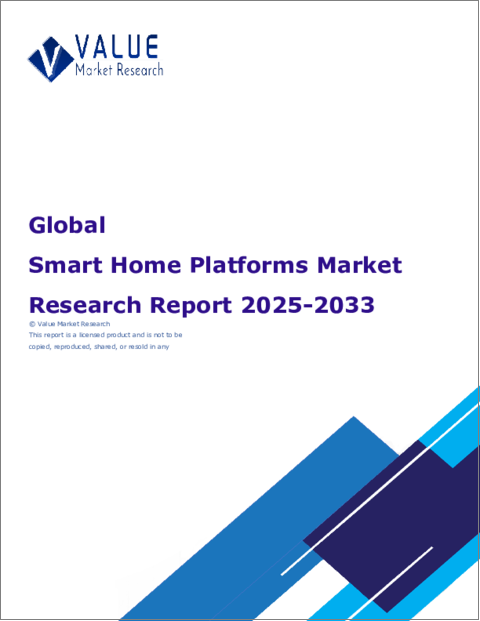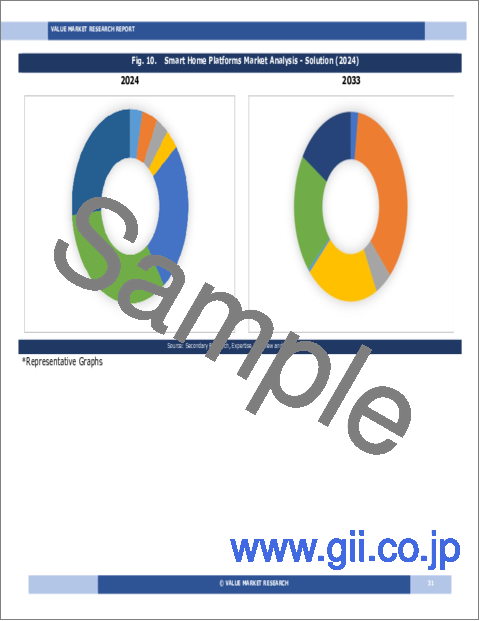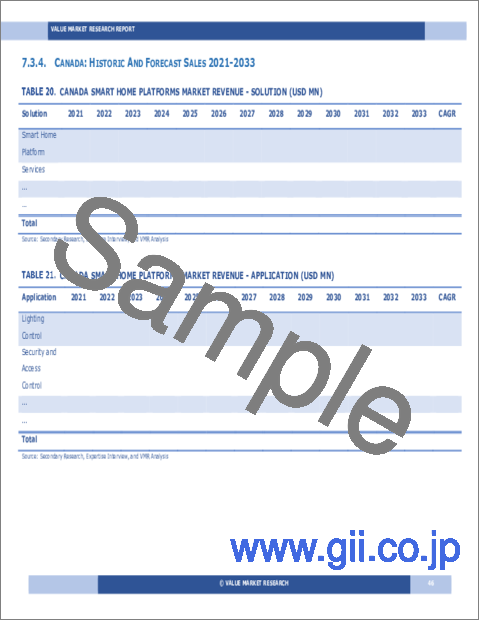|
|
市場調査レポート
商品コード
1732770
スマートホームプラットフォームの世界市場調査レポート:産業分析、規模、シェア、成長、動向、2025年から2033年までの予測Global Smart Home Platforms Market Research Report - Industry Analysis, Size, Share, Growth, Trends and Forecast 2025 to 2033 |
||||||
カスタマイズ可能
|
|||||||
| スマートホームプラットフォームの世界市場調査レポート:産業分析、規模、シェア、成長、動向、2025年から2033年までの予測 |
|
出版日: 2025年05月01日
発行: Value Market Research
ページ情報: 英文 110 Pages
納期: 即日から翌営業日
|
- 全表示
- 概要
- 図表
- 目次
スマートホームプラットフォームの世界市場規模は、2024年の969億米ドルから2033年には3,522億7,000万米ドルに成長し、2026年から2033年の予測期間中に15.42%の堅調な年間平均成長率(CAGR)を示すと予測されます。
スマートホームプラットフォーム市場は、コネクテッドデバイス、AI、音声技術の進歩が住宅生活環境を再定義しており、強力な勢いを示しています。カスタマイズ、快適性、セキュリティ、エネルギー効率に対する消費者の欲求の高まりが、照明、HVAC、セキュリティシステム、エンターテイメントをシームレスに接続する統合プラットフォームの採用を促進しています。これらのプラットフォームは、デバイスの相互運用性、データ分析、自動化をオーケストレーションする集中ハブの役割を果たし、住宅所有者にデジタル・エコシステムの直感的なコントロールを提供します。相互運用性の標準が成熟し、エッジコンピューティング機能が向上するにつれて、スマートホームプラットフォームは、より自律的でコンテキストを認識する機能へと進化します。
さらに、音声アシスタント対応デバイスの急増とAIによるパーソナライゼーションが、スマートホームとユーザーとのインタラクションを再構築しています。これらのプラットフォームは、機械学習アルゴリズムを活用してユーザーの好みを学習し、行動を予測し、利便性と省エネのためにデバイスの動作を最適化します。再生可能エネルギー・システムやスマート・グリッドとの統合も、スマート・ホームのエコシステムを、より広範なエネルギー管理と持続可能性の目標に貢献する重要なものとして位置付けています。このようなエネルギーを意識した自動化は、二酸化炭素排出量を削減するという世界のコミットメントに沿いながら、コスト削減を促進します。
セキュリティとプライバシーへの配慮が市場の技術革新を促進し、エンド・ツー・エンドの暗号化、生体認証、異常検知を組み込んだプラットフォームが増えています。スマートホームがより複雑化するにつれ、ユーザーの信頼と脅威に対する回復力を維持するためには、全体的なサイバーセキュリティの枠組みが不可欠となります。IoT、エッジインテリジェンス、クラウドオーケストレーションの継続的な融合は、自律性の強化、パーソナライズされた体験、スマートシティと都市インフラ内での統合の拡大を特徴とするスマートホームプラットフォームの未来を予告し、住宅生活をインテリジェンスと持続可能性の新たなパラダイムに高めます。
当社のレポートは、様々な産業や市場に関する包括的かつ実用的な洞察をお客様に提供するために綿密に作成されています。各レポートは、市場情勢を完全に理解するために、いくつかの重要な要素を含んでいます:
市場概要:定義、分類、業界の現状など、市場に関する詳細なイントロダクション。
市場促進要因:市場成長に影響を与える主な促進要因・抑制要因・市場促進要因・課題を詳細に分析します。このセクションでは、技術の進歩、規制の変更、新たな動向などの要因を検証します。
セグメンテーション分析:製品タイプ、用途、エンドユーザー、地域などの基準に基づき、市場を明確なセグメントに内訳。この分析により、各セグメントの業績と将来性を明らかにします。
競合情勢:市場シェア、製品ポートフォリオ、戦略的イニシアティブ、財務実績など、主要市場企業の包括的評価。主要企業が採用する競合力学と主要戦略に関する考察を提供します。
市場予測:過去のデータと現在の市場状況に基づき、一定期間における市場規模と成長動向を予測します。これには、定量的分析と将来の市場軌跡を示すグラフ表示が含まれます。
地域分析:地域ごとの市場パフォーマンスを評価し、主要市場や地域動向を明らかにします。地域の市場力学とビジネスチャンスを理解するのに役立ちます。
新たな動向と機会:現在の市場動向と新たな市場動向、技術革新、潜在的な投資対象分野を特定します。将来の市場開拓と成長見通しに関する洞察を提供します。
目次
第1章 序文
第2章 エグゼクティブサマリー
- 市場のハイライト
- 世界市場スナップショット
第3章 スマートホームプラットフォーム産業分析
- イントロダクション:市場力学
- 市場促進要因
- 市場抑制要因
- 市場機会
- 業界動向
- ファイブフォース分析
- 市場の魅力分析
第4章 バリューチェーン分析
- バリューチェーン分析
- 原材料分析
- 原材料リスト
- 原材料メーカーリスト
- 主要原材料の価格動向
- 潜在的バイヤーのリスト
- マーケティングチャネル
- ダイレクトマーケティング
- インダイレクトマーケティング
- マーケティングチャネル発展動向
第5章 スマートホームプラットフォームの世界市場分析:ソリューション別
- ソリューション別の概要
- ソリューション別の過去および予測データ分析
- スマートホームプラットフォーム
- サービス
第6章 スマートホームプラットフォームの世界市場分析:用途別
- 用途別の概要
- 用途別の過去および予測データ分析
- 照明制御
- セキュリティとアクセス制御
- HVACと空調制御
- ホームエンターテイメント&マルチメディア制御
- その他
第7章 スマートホームプラットフォームの世界市場分析:地域別
- 地域別展望
- イントロダクション
- 北米売上分析
- 概要、実績と予測
- 北米:セグメント別
- 北米:国別
- 米国
- カナダ
- メキシコ
- 欧州売上分析
- 概要、実績と予測
- 欧州:セグメント別
- 欧州:国別
- 英国
- フランス
- ドイツ
- イタリア
- ロシア
- その他欧州
- アジア太平洋地域売上分析
- 概要、実績と予測
- アジア太平洋地域:セグメント別
- アジア太平洋地域:国別
- 中国
- インド
- 日本
- 韓国
- オーストラリア
- 東南アジア
- その他アジア太平洋地域
- ラテンアメリカ売上分析
- 概要、実績と予測
- ラテンアメリカ:セグメント別
- ラテンアメリカ:国別
- ブラジル
- アルゼンチン
- ペルー
- チリ
- その他ラテンアメリカ
- 中東・アフリカ売上分析
- 概要、実績と予測
- 中東・アフリカ:セグメント別
- 中東・アフリカ:国別
- サウジアラビア
- アラブ首長国連邦
- イスラエル
- 南アフリカ
- その他中東とアフリカ
第8章 スマートホームプラットフォーム企業の競合情勢
- スマートホームプラットフォーム市場競合
- 提携・協力・合意
- 合併・買収
- 新製品発表
- その他の開発
第9章 企業プロファイル
- 上位企業の市場シェア分析
- 市場集中度
- Apple Inc.
- Google LLC
- Cisco Systems Inc
- Resideo Technologies Inc
- Amazon Inc
- LG Electronics
- Samsung Electronics Co. LTD
- Siemens AG
- Robert Bosch Smart Home GmbH
- General Electrical Company
LIST OF TABLES
- Market Snapshot
- Drivers: Impact Analysis
- Restraints: Impact Analysis
- List of Raw Material
- List of Raw Material Manufactures
- Analysis By Solution (USD MN)
- Smart Home Platform Market Sales By Geography (USD MN)
- Services Market Sales By Geography (USD MN)
- Analysis By Application (USD MN)
- Lighting Control, Market Sales By Geography (USD MN)
- Security and Access Control, Market Sales By Geography (USD MN)
- HVAC & Climate Control, Market Sales By Geography (USD MN)
- Home Entertainment & Multimedia Control Market Sales By Geography (USD MN)
- Others Market Sales By Geography (USD MN)
- Global Smart Home Platforms Market Sales By Geography (USD MN)
- North America Market Analysis (USD MN)
- United States Market Analysis (USD MN)
- Canada Market Analysis (USD MN)
- Mexico Market Analysis (USD MN)
- Europe Market Analysis (USD MN)
- Europe Market Estimate By Country (USD MN)
- United Kingdom Market Analysis (USD MN)
- France Market Analysis (USD MN)
- Germany Market Analysis (USD MN)
- Italy Market Analysis (USD MN)
- Russia Market Analysis (USD MN)
- Spain Market Analysis (USD MN)
- Rest of Europe Market Analysis (USD MN)
- Asia Pacific Market Analysis (USD MN)
- China Market Analysis (USD MN)
- Japan Market Analysis (USD MN)
- India Market Analysis (USD MN)
- South Korea Market Analysis (USD MN)
- Australia Market Analysis (USD MN)
- South East Asia Market Analysis (USD MN)
- Rest of Asia Pacific Market Analysis (USD MN)
- Latin America Market Analysis (USD MN)
- Brazil Market Analysis (USD MN)
- Argentina Market Analysis (USD MN)
- Peru Market Analysis (USD MN)
- Chile Market Analysis (USD MN)
- Rest of Latin America Market Analysis (USD MN)
- Middle East & Africa Market Analysis (USD MN)
- Saudi Arabia Market Analysis (USD MN)
- UAE Market Analysis (USD MN)
- Israel Market Analysis (USD MN)
- South Africa Market Analysis (USD MN)
- Rest of Middle East and Africa Market Analysis (USD MN)
- Partnership/Collaboration/Agreement
- Mergers And Acquisition
LIST OF FIGURES
- Research Scope of Smart Home Platforms Report
- Market Research Process
- Market Research Methodology
- Global Smart Home Platforms Market Size, By Region (USD MN)
- Porters Five Forces Analysis
- Market Attractiveness Analysis By Solution
- Market Attractiveness Analysis By Application
- Market Attractiveness Analysis By Region
- Value Chain Analysis
- Global Market Analysis By Solution (USD MN)
- Smart Home Platform Market Sales By Geography (USD MN)
- Services Market Sales By Geography (USD MN)
- Global Market Analysis By Application (USD MN)
- Lighting Control, Market Sales By Geography (USD MN)
- Security and Access Control, Market Sales By Geography (USD MN)
- HVAC & Climate Control, Market Sales By Geography (USD MN)
- Home Entertainment & Multimedia Control Market Sales By Geography (USD MN)
- Others Market Sales By Geography (USD MN)
- Global Market Sales (USD MN)
- North America Market Sales (USD MN)
- Europe Market Sales (USD MN)
- Asia Pacific Market Sales (USD MN)
- Latin America Market Sales (USD MN)
- Middle East & Africa Market Sales (USD MN)
- Recent Development in Industry
- Top Company Market Share Analysis
Kindly note that the above listed are the basic tables and figures of the report and are not limited to the TOC.
Global Smart Home Platforms Market size is anticipated to grow from USD 96.9 Billion in 2024 to USD 352.27 Billion by 2033, showcasing a robust Compound Annual Growth Rate (CAGR) of 15.42% during the forecast period of 2026 to 2033.
The Smart Home Platforms Market demonstrates compelling momentum as advancements in connected devices, AI, and voice technologies redefine residential living environments. Increasing consumer desire for customization, comfort, security, and energy efficiency fuels the adoption of integrated platforms that seamlessly connect lighting, HVAC, security systems, and entertainment. These platforms serve as centralized hubs orchestrating device interoperability, data analytics, and automation, offering homeowners intuitive control over their digital ecosystems. As interoperability standards mature and edge computing capabilities improve, smart home platforms evolve toward more autonomous, context-aware functionalities.
Moreover, the surge in voice assistant-enabled devices and AI-enhanced personalization is reshaping user interactions with smart homes. These platforms leverage machine learning algorithms to learn user preferences, predict behaviors, and optimize device operation for convenience and energy savings. Integration with renewable energy systems and smart grids also positions smart home ecosystems as vital contributors to broader energy management and sustainability objectives. This energy-conscious automation promotes cost savings while aligning with global commitments to reduce carbon footprints.
Security and privacy considerations are catalyzing market innovation, with platforms increasingly incorporating end-to-end encryption, biometric authentication, and anomaly detection. As smart homes become more complex, holistic cybersecurity frameworks will be critical to maintain user trust and resilience against threats. The ongoing convergence of IoT, edge intelligence, and cloud orchestration heralds a future for smart home platforms characterized by enhanced autonomy, personalized experiences, and increased integration within smart cities and urban infrastructures, elevating residential living to new paradigms of intelligence and sustainability.
Our reports are meticulously crafted to provide clients with comprehensive and actionable insights into various industries and markets. Each report encompasses several critical components to ensure a thorough understanding of the market landscape:
Market Overview: A detailed introduction to the market, including definitions, classifications, and an overview of the industry's current state.
Market Dynamics: In-depth analysis of key drivers, restraints, opportunities, and challenges influencing market growth. This section examines factors such as technological advancements, regulatory changes, and emerging trends.
Segmentation Analysis: Breakdown of the market into distinct segments based on criteria like product type, application, end-user, and geography. This analysis highlights the performance and potential of each segment.
Competitive Landscape: Comprehensive assessment of major market players, including their market share, product portfolio, strategic initiatives, and financial performance. This section provides insights into the competitive dynamics and key strategies adopted by leading companies.
Market Forecast: Projections of market size and growth trends over a specified period, based on historical data and current market conditions. This includes quantitative analyses and graphical representations to illustrate future market trajectories.
Regional Analysis: Evaluation of market performance across different geographical regions, identifying key markets and regional trends. This helps in understanding regional market dynamics and opportunities.
Emerging Trends and Opportunities: Identification of current and emerging market trends, technological innovations, and potential areas for investment. This section offers insights into future market developments and growth prospects.
SEGMENTATION COVERED IN THE REPORT
By Solution
- Smart Home Platform
- Services
By Application
- Lighting Control,
- Security and Access Control,
- HVAC & Climate Control,
- Home Entertainment & Multimedia Control
- Others
- COMPANIES PROFILED
- Apple Inc.
- Google LLC
- Cisco Systems Inc
- Resideo Technologies Inc
- Amazon Inc
- LG Electronics
- Samsung Electronics Co. LTD
- Siemens AG
- Robert Bosch Smart Home GmbH
- General Electrical Company
- The above list can be customized.
TABLE OF CONTENTS
1. PREFACE
- 1.1. Report Description
- 1.1.1 Objective
- 1.1.2 Target Audience
- 1.1.3 Unique Selling Proposition (USP) & offerings
- 1.2. Research Scope
- 1.3. Research Methodology
- 1.3.1 Market Research Process
- 1.3.2 Market Research Methodology
2. EXECUTIVE SUMMARY
- 2.1. Highlights of Market
- 2.2. Global Market Snapshot
3. SMART HOME PLATFORMS INDUSTRY ANALYSIS
- 3.1. Introduction - Market Dynamics
- 3.2. Market Drivers
- 3.3. Market Restraints
- 3.4. Opportunities
- 3.5. Industry Trends
- 3.6. Poerter's Five Force Analysis
- 3.7. Market Attractiveness Analysis
- 3.7.1 Market Attractiveness Analysis By Solution
- 3.7.2 Market Attractiveness Analysis By Application
- 3.7.3 Market Attractiveness Analysis By Region
4. VALUE CHAIN ANALYSIS
- 4.1. Value Chain Analysis
- 4.2. Raw Material Analysis
- 4.2.1 List of Raw Materials
- 4.2.2 Raw Material Manufactures List
- 4.2.3 Price Trend of Key Raw Materials
- 4.3. List of Potential Buyers
- 4.4. Marketing Channel
- 4.4.1 Direct Marketing
- 4.4.2 Indirect Marketing
- 4.4.3 Marketing Channel Development Trend
5. GLOBAL SMART HOME PLATFORMS MARKET ANALYSIS BY SOLUTION
- 5.1. Overview By Solution
- 5.2. Historical and Forecast Data Analysis By Solution
- 5.3. Smart Home Platform Historic and Forecast Sales By Regions
- 5.4. Services Historic and Forecast Sales By Regions
6. GLOBAL SMART HOME PLATFORMS MARKET ANALYSIS BY APPLICATION
- 6.1. Overview By Application
- 6.2. Historical and Forecast Data Analysis By Application
- 6.3. Lighting Control, Historic and Forecast Sales By Regions
- 6.4. Security and Access Control, Historic and Forecast Sales By Regions
- 6.5. HVAC & Climate Control, Historic and Forecast Sales By Regions
- 6.6. Home Entertainment & Multimedia Control Historic and Forecast Sales By Regions
- 6.7. Others Historic and Forecast Sales By Regions
7. GLOBAL SMART HOME PLATFORMS MARKET ANALYSIS BY GEOGRAPHY
- 7.1. Regional Outlook
- 7.2. Introduction
- 7.3. North America Sales Analysis
- 7.3.1 Overview, Historic and Forecast Data Sales Analysis
- 7.3.2 North America By Segment Sales Analysis
- 7.3.3 North America By Country Sales Analysis
- 7.3.4 United States Sales Analysis
- 7.3.5 Canada Sales Analysis
- 7.3.6 Mexico Sales Analysis
- 7.4. Europe Sales Analysis
- 7.4.1 Overview, Historic and Forecast Data Sales Analysis
- 7.4.2 Europe By Segment Sales Analysis
- 7.4.3 Europe By Country Sales Analysis
- 7.4.4 United Kingdom Sales Analysis
- 7.4.5 France Sales Analysis
- 7.4.6 Germany Sales Analysis
- 7.4.7 Italy Sales Analysis
- 7.4.8 Russia Sales Analysis
- 7.4.9 Rest Of Europe Sales Analysis
- 7.5. Asia Pacific Sales Analysis
- 7.5.1 Overview, Historic and Forecast Data Sales Analysis
- 7.5.2 Asia Pacific By Segment Sales Analysis
- 7.5.3 Asia Pacific By Country Sales Analysis
- 7.5.4 China Sales Analysis
- 7.5.5 India Sales Analysis
- 7.5.6 Japan Sales Analysis
- 7.5.7 South Korea Sales Analysis
- 7.5.8 Australia Sales Analysis
- 7.5.9 South East Asia Sales Analysis
- 7.5.10 Rest Of Asia Pacific Sales Analysis
- 7.6. Latin America Sales Analysis
- 7.6.1 Overview, Historic and Forecast Data Sales Analysis
- 7.6.2 Latin America By Segment Sales Analysis
- 7.6.3 Latin America By Country Sales Analysis
- 7.6.4 Brazil Sales Analysis
- 7.6.5 Argentina Sales Analysis
- 7.6.6 Peru Sales Analysis
- 7.6.7 Chile Sales Analysis
- 7.6.8 Rest of Latin America Sales Analysis
- 7.7. Middle East & Africa Sales Analysis
- 7.7.1 Overview, Historic and Forecast Data Sales Analysis
- 7.7.2 Middle East & Africa By Segment Sales Analysis
- 7.7.3 Middle East & Africa By Country Sales Analysis
- 7.7.4 Saudi Arabia Sales Analysis
- 7.7.5 UAE Sales Analysis
- 7.7.6 Israel Sales Analysis
- 7.7.7 South Africa Sales Analysis
- 7.7.8 Rest Of Middle East And Africa Sales Analysis
8. COMPETITIVE LANDSCAPE OF THE SMART HOME PLATFORMS COMPANIES
- 8.1. Smart Home Platforms Market Competition
- 8.2. Partnership/Collaboration/Agreement
- 8.3. Merger And Acquisitions
- 8.4. New Product Launch
- 8.5. Other Developments
9. COMPANY PROFILES OF SMART HOME PLATFORMS INDUSTRY
- 9.1. Top Companies Market Share Analysis
- 9.2. Market Concentration Rate
- 9.3. Apple Inc.
- 9.3.1 Company Overview
- 9.3.2 Company Revenue
- 9.3.3 Products
- 9.3.4 Recent Developments
- 9.4. Google LLC
- 9.4.1 Company Overview
- 9.4.2 Company Revenue
- 9.4.3 Products
- 9.4.4 Recent Developments
- 9.5. Cisco Systems Inc
- 9.5.1 Company Overview
- 9.5.2 Company Revenue
- 9.5.3 Products
- 9.5.4 Recent Developments
- 9.6. Resideo Technologies Inc
- 9.6.1 Company Overview
- 9.6.2 Company Revenue
- 9.6.3 Products
- 9.6.4 Recent Developments
- 9.7. Amazon Inc
- 9.7.1 Company Overview
- 9.7.2 Company Revenue
- 9.7.3 Products
- 9.7.4 Recent Developments
- 9.8. LG Electronics
- 9.8.1 Company Overview
- 9.8.2 Company Revenue
- 9.8.3 Products
- 9.8.4 Recent Developments
- 9.9. Samsung Electronics Co. LTD
- 9.9.1 Company Overview
- 9.9.2 Company Revenue
- 9.9.3 Products
- 9.9.4 Recent Developments
- 9.10. Siemens AG
- 9.10.1 Company Overview
- 9.10.2 Company Revenue
- 9.10.3 Products
- 9.10.4 Recent Developments
- 9.11. Robert Bosch Smart Home GmbH
- 9.11.1 Company Overview
- 9.11.2 Company Revenue
- 9.11.3 Products
- 9.11.4 Recent Developments
- 9.12. General Electrical Company
- 9.12.1 Company Overview
- 9.12.2 Company Revenue
- 9.12.3 Products
- 9.12.4 Recent Developments






